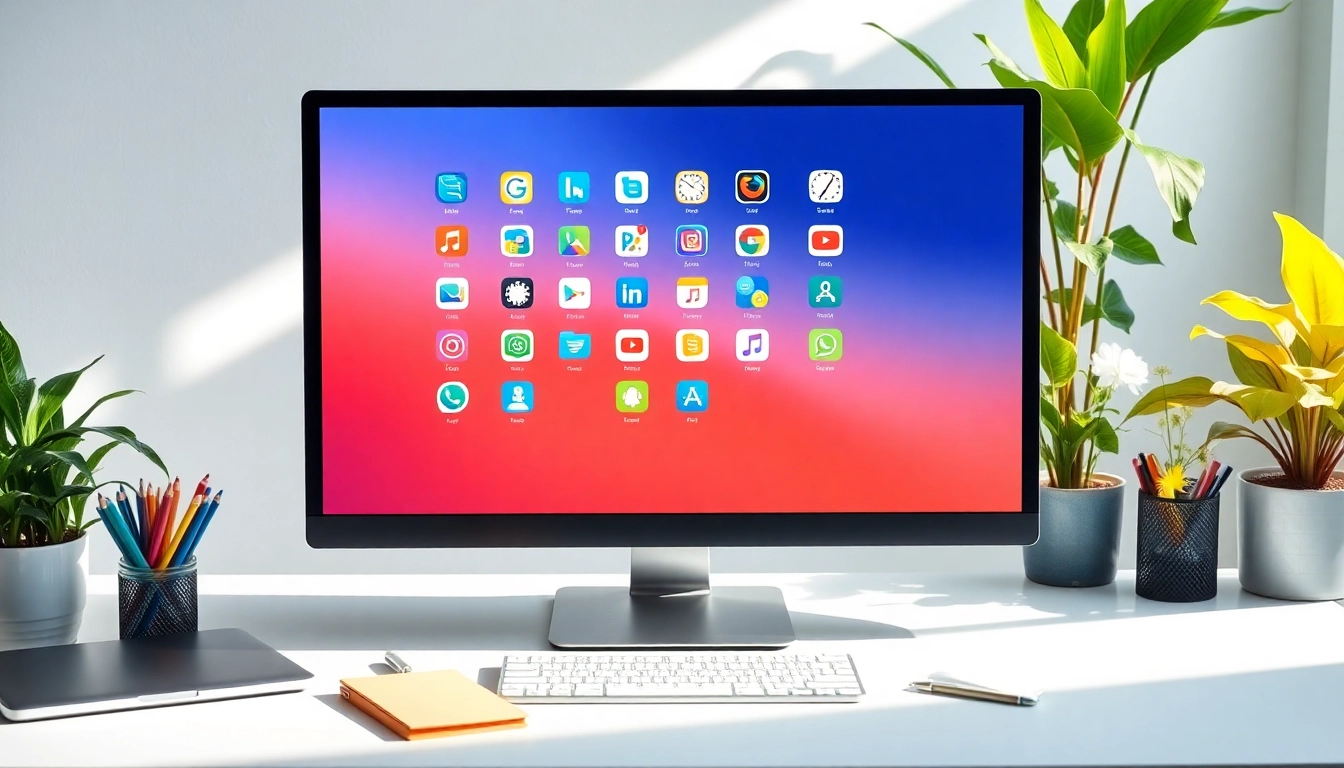Understanding Icons in Design
What Are Icons and Their Purpose?
Icons are small graphical representations that convey meaning and communicate ideas quickly to users without the need for words. They serve as visual shortcuts and enhance the user interface by providing intuitive signals about functions, actions, and navigation elements. For instance, a trash bin icon commonly symbolizes the delete action, while a magnifying glass represents search capabilities.
The primary purpose of icons is to simplify communication through imagery, ensuring users can navigate and interact with applications, websites, and devices efficiently. In the digital age, where attention spans are short, these visual elements become even more critical, helping to guide users seamlessly from one task to another. Understanding how to utilize icons effectively can greatly enhance user experience.
Importance of Iconography in User Experience
Effective iconography plays a pivotal role in enhancing user experience (UX). It allows users to process information faster, as symbols can be universally recognized, transcending language barriers. Well-designed icons can create a more engaging and aesthetically pleasing interface, thereby improving usability and satisfaction.
Moreover, icons promote a sense of familiarity and consistency throughout applications or websites. When icons are designed and utilized appropriately, they can significantly reduce user frustration, streamline interactions, and ultimately lead to higher conversion rates. Just as important is the fact that a cohesive set of icons can also help establish a brand’s identity, making it memorable and recognizable.
Common Icon Types and Styles
Icons come in various forms and styles, each serving different functions and aesthetic preferences. Common types include:
- Flat Icons: These are simple and two-dimensional, focusing on clean lines and minimal detail. They’re popular for modern web design due to their clarity and ease of understanding.
- 3D Icons: Offering depth and perspective, 3D icons provide a more lifelike representation. Although they can be visually engaging, they risk overwhelming users if not implemented tastefully.
- Line Icons: Utilizing only outlines without fill, line icons are versatile and clean. They can be easily recognized and are particularly effective in creating a minimalist design.
- Colored Icons: These icons use vibrant colors and shades, allowing for more expressive designs. They’re often associated with specific brands or themes.
- Animated Icons: Adding motion to icons can capture users’ attention and provide additional context for actions or notifications, enhancing the interactive experience.
How to Choose the Right Icons
Factors to Consider When Selecting Icons
Choosing the right icons is essential for ensuring that they convey the intended messages effectively. Here are factors to consider:
- Clarity: Icons should be easily recognizable. Ensure that the design reflects the action or object it represents to avoid confusion.
- Consistency: All icons in a set should share a cohesive style and color scheme to maintain visual harmony throughout your project.
- Scalability: Icons need to be scalable without losing quality. Opt for vector formats (like SVG) to ensure they look crisp on screens of all sizes.
- Context: Evaluate the context in which icons will be used. Consider the target audience and the environment (mobile, desktop, or print) to make informed design choices.
Resources for High-Quality Icons
There are numerous resources available for high-quality icons that can elevate your design. Some widely recognized platforms include:
- Flaticon: A vast library offering millions of free and premium icons across various styles.
- Icons8: Known for its extensive collection of consistent and high-quality icons, including animated options.
- Noun Project: A platform that boasts millions of icons contributed by a global community of designers.
- Iconfinder: Offers a marketplace for both free and premium icons, illustrations, and design elements.
- Streamline Icons: Famous for unique sets crafted by expert designers, which provide a distinctive touch to any project.
Customization Tips for Unique Icon Designs
While there are many great resources for icons, customizing icons can further enhance their uniqueness and relevance to your brand or project. Here are some tips for customization:
- Modify Colors: Altering the color palette to align with your brand guidelines can make your icons resonate more with your audience.
- Add Personal Elements: Infusing personal or brand-specific motifs into existing icon designs can create a deeper connection with users.
- Change Sizes and Shapes: Adjusting the size or the overall shape can help your icons fit better within your design context and improve functionality.
- Utilize Shadows and Gradients: Adding depth through shadows or gradients can make icons visually striking but ensure that these elements don’t detract from clarity.
Implementing Icons in Your Projects
Best Practices for Icon Integration
Integrating icons effectively into your projects requires adherence to established best practices:
- Use Alt Text: Ensure that you provide descriptive alt text for icons to enhance accessibility and improve SEO.
- Maintain Proximity: Position icons close to related text or actions to establish clear associations and enhance usability.
- Test Different Sizes: Experiment with various icon sizes to find an optimal balance that improves readability without overcrowding the layout.
- Limit Usage: Avoid overusing icons; choose relevant ones that add value to user interactions and do not overwhelm the user interface.
Tools and Software for Icon Design
A variety of tools and software can assist in designing custom icons. Popular options include:
- Adobe Illustrator: A leading vector graphics editor, ideal for creating and custom designing icons.
- Sketch: Favored by many UX and UI designers, it is robust for crafting icons along with entire layouts.
- Figma: A collaborative design tool that allows for real-time editing and sharing, making it easy to create and iterate on icon designs.
- Affinity Designer: An affordable alternative to Illustrator that still offers powerful vector design capabilities.
- Canva: While not as powerful for detailed vector work, its user-friendly interface makes it suitable for quick icon designs and customizations.
Case Studies: Successful Icon Usage Examples
To illustrate effective usage, here are a couple of case studies where iconography has played a significant role:
- Airbnb: The platform strategically utilizes well-crafted icons that convey directives and features succinctly, enhancing the overall booking experience. Users are naturally drawn to the icons that guide their journey from searching for a property to finalizing a booking.
- Slack: Icons used in Slack are simple yet recognizable, supporting its intuitive communication platform. Each icon’s design aligns with its functionality, ensuring users can navigate channels and options effortlessly.
Trends in Icon Design
Current Trends in Graphic and UI Icons
The landscape of icon design continuously evolves, reflecting changing design practices interconnected with technology and user preferences. Key trends include:
- Minimalism: The movement toward minimal design continues, emphasizing simplicity and function over ornamental elements.
- Custom Icons: Businesses are moving away from generic icons and towards bespoke designs that resonate with their branding and target audiences.
- 3D and Depth Effects: As technology advances, the use of 3D icons and depth effects is becoming increasingly popular to add realism and tangibility.
- Micro-Animations: Short animations applied to icons enhance the interactivity of web and app interfaces, making user interactions more engaging.
Predictions for Future Iconography Developments
As technology and design continue to evolve, several predictions regarding the future of iconography include:
- Augmented Reality (AR) Icons: As AR technology becomes more integrated into everyday applications, icons may evolve to provide interactive 3D representations in augmented environments.
- Personalized Icons: The use of AI could allow for adaptable icons based on user behavior and preferences, providing a more tailored experience.
- Increased Focus on Inclusivity: Future designs will likely prioritize accessibility, ensuring that icons are easily perceivable by a diverse range of users.
How to Stay Updated with Icon Design Trends
Staying abreast of current trends in icon design requires continuous exploration and learning. Here are some effective strategies:
- Follow Design Blogs: Websites like Smashing Magazine, Abduzeedo, and Creative Bloq offer invaluable insights and roundups of current design styles.
- Participate in Design Communities: Engaging with platforms such as Behance and Dribbble allows for interaction with other designers, sharing ideas and inspirations.
- Attend Webinars and Conferences: Events focused on design trends and technology provide opportunities to learn from industry leaders and network with peers.
- Utilize Social Media: Platforms like Pinterest or Instagram are powerful for discovering visual trends and innovative designs in real time.
Measuring the Impact of Icons
Metrics for Evaluating Icon Effectiveness
Determining the effectiveness of icons involves careful evaluation through various metrics:
- User Engagement Rates: Monitoring how often users interact with icons can highlight their effectiveness in encouraging actions.
- Error Rates: A high number of user errors related to misunderstandings of icons can indicate a need for redesign or retraining.
- Time on Task: Assessing how long users take to complete tasks that involve icon navigation can provide insights into the clarity of your icon design.
- User Feedback: Collecting qualitative data through surveys or user testing can reveal what users think about the icons and their functionality.
Feedback Techniques for Icon Usage
Gathering feedback is crucial in improving the effectiveness of icons. Here are some techniques:
- User Testing: Conducting sessions where users are observed interacting with icons will provide direct insights into usability and clarity.
- A/B Testing: Presenting two variations of an icon and measuring which one performs better can clarify user preferences.
- Surveys and Polls: Implementing surveys allows users to express their opinions on icon designs, offering valuable firsthand feedback.
Improving Engagement Through Icon Analysis
Analyzing icon performance can unveil opportunities for improvement and ultimately drive user engagement:
- Identify Underperforming Icons: Regularly review data on interactions with each icon to pinpoint areas requiring revision or redesign.
- Iterate on Design: Based on user feedback and performance data, continue to refine and iterate on icon designs to enhance their effectiveness.
- Enhance Visual Hierarchy: Adjusting icon sizes, colors, or designs can amplify their visual prominence within the layout, increasing user interaction.



